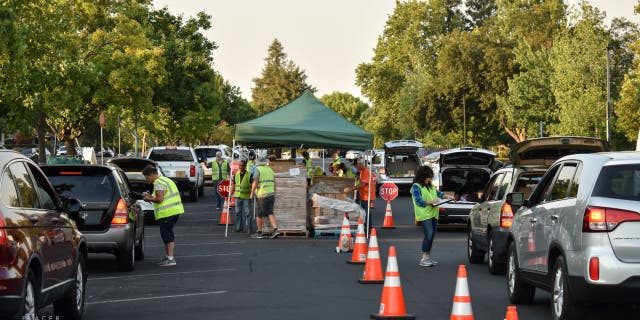Surging inflation causes food insecurity for working families as food banks struggle to meet demand
NEWYou can now listen to Fox News articles!
Rising inflation and fuel costs in the United States have resulted in more Americans finding themselves in need of help from their local food bank and leaders in the industry tell Fox News Digital that working families are becoming fixtures in the long lines at food distribution sites.
Feeding South Dakota, the only food bank that serves the 900,000 people in the state’s 66 counties, has seen an influx of working families facing food insecurity as inflation and high fuel costs make it even more difficult for food banks to keep up with demand.
“We’ve had an over 20% increase in families for our statewide mobile service in the past 12 months,” Matt Burns, chief operating officer at Feeding South Dakota, told Fox News Digital. “But you see people in between jobs who maybe normally have enough and their budget is sufficient enough in their house budget to meet all their food needs but because of inflationary pressures they’re making really tough choices between food and other necessities like housing, medication, and car payments. All these things put incredible pressures on household budgets and so that is all contributing to the need and why we’re seeing that 20% increase.”
“When you’re seeing a 9.1% here in recent months, you just cannot keep up with that,” Burns added. “And so that leads to families making super tough choices.”
FOOD BANKS ARE ALREADY WORRIED ABOUT FALL, WINTER — SOME FAMILIES MAY NOT HAVE TURKEYS THIS YEAR

A grandmother and her granddaughter receive food at Feeding South Dakota
(Feeding South Dakota)
While many harbor the perception that food banks primarily serve the homeless, other leaders in the food bank industry nationwide told Fox News Digital that they are also witnessing the same increase in the number of working families turning to food banks that Feeding South Dakota is experiencing.
“The basis for our services are the homeless, the people that are really struggling, but now it’s shifted, and it’s definitely working families now,” Jorge Lupercio, Director of Operations at Placer Food Bank in Roseville, California, told Fox News Digital. He also explained that times are even tougher for families with children who are out of school for the summer and not receiving the meals they usually receive there.
Lupercio said the need for food at Placer Food Bank has risen significantly over the past year as inflation has skyrocketed in the United States.
FOOD BANKS IN AMERICA EXPERIENCE SURGING DEMAND: ‘NO SIGN OF IT SLOWING DOWN ANY TIME SOON’
During the 2019-2020 fiscal year, his food bank distributed 324,648 pounds of food to 22,525 people at its monthly drive through distribution centers. In the 2021-2022 fiscal year, over 1.4 million pounds of food was distributed to 62,347 people at those sites.

A drive-thru food distribution site at Placer Food Bank
(Placer Food Bank)
Aramelle Wheeler, marketing & communications coordinator at the Food Bank of Northern Nevada in Reno, told Fox News Digital that her organization typically serves the working poor but has seen an increase in lower-middle class and middle class families who have found themselves unable to afford food.
“We have seen even more of a shift with the middle class, especially when businesses shut down and a lot of people found themselves out of work due to COVID we saw that influx, and we’ve seen a lot of those people not being able to catch up like they thought they would have by now,” Wheeler said.
The issue “continues to balloon” as prices for everyday goods go up amid record inflation, Wheeler said, adding that FBNN is serving 117,000 Nevadans monthly on average this summer, a 17% increase from last year.
AS INFLATION SOARS, FOOD BANKS STRUGGLE TO MEET HIGHER DEMAND AND SKYROCKETING PRICES
The surging inflation that is driving the increased need at food banks across the country has affected Americans of all backgrounds and financial situations, which is evidenced by the long lines in Westchester County, New York, the second-wealthiest county in the state.

Food bank clients at Food Bank of Northern Nevada
(Food Bank of Northern Nevada)
Karen Erren, president and CEO of Feeding Westchester, told Fox News Digital that her organization has expanded its food distribution times and the line is often filled with people in bright orange uniforms who have come from job sites.
“We serve children, we serve seniors, we serve hardworking families who just can’t make ends meet,” Erren said, adding that the demand she has seen recently is higher than it has ever been.
“I got a really daunting email from one of our great partners yesterday who said that in the two distributions they did they never, and I don’t use that word lightly, they’ve never had so many people in line,” Erren said. “Inflation is hurting people.”
Erren explained that Feeding Westchester conducted a community needs assessment, which surveyed over 600 clients and two-thirds of them said that the food pantry they visit was their primary source of food.
FOOD BANKS ‘NOT IMMUNE’ TO INFLATIONARY PRESSURES: FEEDING AMERICA PRESIDENT

Two sisters receive food at Feeding South Dakota
(Feeding South Dakota)
“People still to this day don’t realize that there is need in our county,” Erren said, adding that her food bank was serving 130,000-150,000 people per month before the COVID-19 pandemic and is now serving over 200,000 people each month on average.
Andrew Olsen, president of Altus Marketing, which works with food banks across the country, told Fox News Digital that he has heard stories from partners where people who were donors to food banks ended up in line needing food themselves.
“The traditional homeless person in need represents a very small percentage of the population that are actually getting food from the food bank network across the country,” Olsen said. “Most often it’s single families, it’s retirees, it’s people who are just down on their luck. The changing demographic of need has much more become families.”
Lupercio said that the “biggest thing” that stands out to him is that “food banking is no longer a temporary service” but rather a permanent fixture in many households.
“What we’re seeing now is that it’s actual working families that, even though the parents work and sometimes even some of the family members contribute, it’s still not enough,” Lupercio said.
US FOOD BANKS SEE LONG LINES, INCREASED DEMAND
Food banks across the country have been forced to purchase more food as demand surges, gas prices increase, and supply chains continue to crunch and that cost has played a significant role in the bottom line, making it even more difficult to serve the food insecure.
Lupercio says that Placer Food Bank was paying $4.03 per gallon for diesel fuel in April of last year and is now paying 65% more and the cost of purchasing basic staples such as eggs and milk has gone up, as well.
“The eggs alone from the same period of April of last year to August of this year, we’ve seen the price climb 93%,” Lupercio said. “The price of milk, we’ve seen it climb 30%, the price of produce that we purchase at the moment we’ve seen it climb 57%.”
All the food bank representatives who spoke to Fox News Digital shared Lupercio’s concerns about rising food prices and fuel costs.

A mother and her two children receive food at Feeding South Dakota
(Feeding South Dakota)
CLICK HERE TO GET THE FOX NEWS APP
“Our new reality is simply that demand for food assistance is going up and availability of food is going down,” Wheeler said. “Like so many food banks around the country, we must continue to purchase a significant amount of food to help our neighbors who are struggling to make ends meet.”
Inflationary pressures, fuel costs and high demand have represented a “compounding problem,” especially when it comes to providing food to people in rural areas, according to Burns.
“Our fuel prices are greatly increased, so the price per pound of our delivered food has greatly increased not only because we’re having to buy more of it, but it costs more to get it out there to those in need,” Burns said.
In New Jersey, a food pantry was recently forced to close down for the first time ever as a result of soaring grocery costs.
“It’s like this perfect storm that they’ve got right now where everything internally is more expensive and there’s a greater need for support and increased fuel prices on top of that,” Olsen said.
Inflation accelerated more than expected to a new four-decade high in June as the consumer price index, a broad measure of the price for everyday goods, including gasoline, groceries and rents, rose 9.1% from a year ago. Prices jumped 1.3% in the one-month period from May. Those figures were both far higher than the 8.8% headline figure and 1% monthly gain forecast by Refinitiv economists.
It marks the fast pace of inflation since December 1981.
Andrew Mark Miller is a writer at Fox News. Find him on Twitter @andymarkmiller and email tips to [email protected].

Comments are closed.